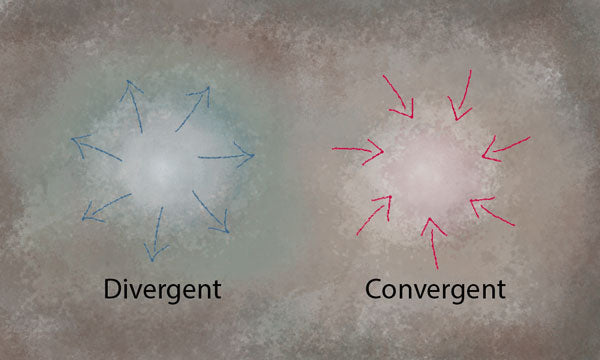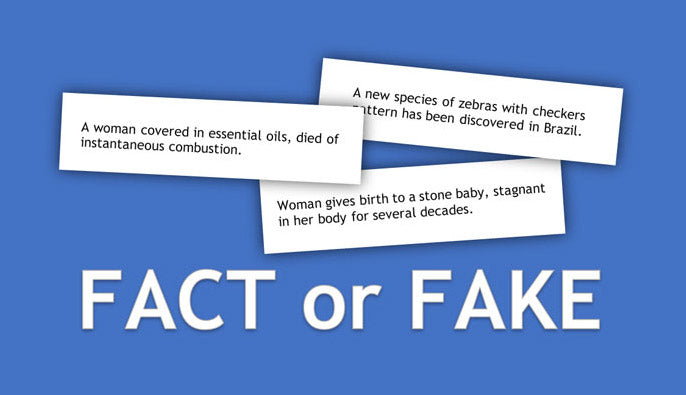Purpose
A useful distinction in thinking process was suggested by Joy Paul Guilford in 1967. Guilford coined convergent thinking in contrast with divergent thinking. With convergent thinking, you are trying to find a single best solution to a given problem. Examples are multiple choice tests, math quizzes, spelling tests and many other standardised tests in education systems. Convergent thinking is systematic and logical (Williams 2003).
In contrast, you can use divergent thinking to create several unique solutions for a given problem. Divergent thinking is creative, spontaneous, non-linear and free-flowing. Several solutions are generated over a short period of time and they can lead to unexpected connections, encouraging discovery of yet more unusual solutions.
After carrying out divergent thinking, you end up with a bunch of solutions. You can then use convergent thinking to organise these solutions, analyse pros and cons of each and find the most optimal answer.
The point of the distinction is that you need both processes for good thinking. Being good at convergent, analytical and logical thinking is not enough as you could miss on some creative solutions. In contrast, just coming up with spontaneous creative ideas is not good enough; you need to examine solutions systematically before embarking on an implementation.
Researchers such as Guilford have found that personality traits tend to promote divergent or convergent thinking. As such, in a given team you will have people who are natural at either divergent or convergent thinking and therefore resistant to the other style of thinking
The following exercise helps to bring this distinction to focus and help delegates see the power of thinking differently to what comes naturally to them.
This exercise is ideal for team building or training delegates on management and creativity.
Objective
Apply divergent thinking to a problem and then use convergent thinking to choose optimal solutions.
What You Need
- Four sets of materials:
- A string several meters long
- A scissor
- A paper bucket
- A piece of cloth
- A stone
- A spoon
- Duct tape
- A plastic bottle full of water
Setup
- Explain the distinction between convergent and divergent thinking.
- Divide the delegates into groups of four.
- Provide the materials to each group.
- Explain that the objective of the exercise is to come up with as many things as they can using the materials provided. They can make gadgets or decorative objects for example. They don’t have to use all the materials, just as much as needed. (Divergent thinking)
- Allocate 20 minutes for this part.
- Ask delegates to choose the most interesting designs for presentation. (Convergent Thinking)
- Allocate 10 minutes.
- Bring everyone back together and ask each team to present their creation. They should explain why they thought their design was interesting.
- Now ask all delegates to examine designs by all groups and go through another phase of convergent thinking together. They must pick the most exceptional design from the set. Explain that this is not a competition and is not about finding a winner. The aim is to focus on the distinction between coming up with lots of ideas quickly (divergent thinking) and then implementing and choosing the best ones systematically (convergent thinking).
- Allocate 10 minutes.
- Follow with a discussion.
Timing
Explaining the Exercise: 5 minutes
Activity: 20 min divergent thinking + 10 convergent thinking + 10 min final convergent thinking = 40 minutes
Group Feedback: 10 minutes
Discussion
What approach did you use to come up with ideas on how to use the materials? How did each member of your team contribute? Did you observe a difference in contribution by team members in terms of divergent and convergent thinking? Was it easy to work in your team on either of the tasks? Did you come up with many ideas or only a few? Which stage did you find more difficult; divergent or convergent thinking? Why?
References
Williams, Y. (2003) “Convergent thinking: definition, examples & quiz”, Education Portal, 13(3).
Soft Skills Training Materials
Get downloadable training materials
Online Train the Trainer Course:
Core Skills
Learn How to Become the Best Trainer in Your Field
All Tags
Training Resources for You

Course Design Strategy
Available as paperback and ebook

Free Training Resources
Download a free comprehensive training package including training guidelines, soft skills training activities, assessment forms and useful training resources that you can use to enhance your courses.

Our Comprehensive Guide to Body Language

Train the Trainer Resources
Get Insights - Read Guides and Books - Attend Courses
Training Materials
Get downloadable training materials on: Management Training, Personal Development, Interpersonal Development, Human Resources, and Sales & Marketing














Leave a comment
All comments are moderated before being published.
This site is protected by hCaptcha and the hCaptcha Privacy Policy and Terms of Service apply.